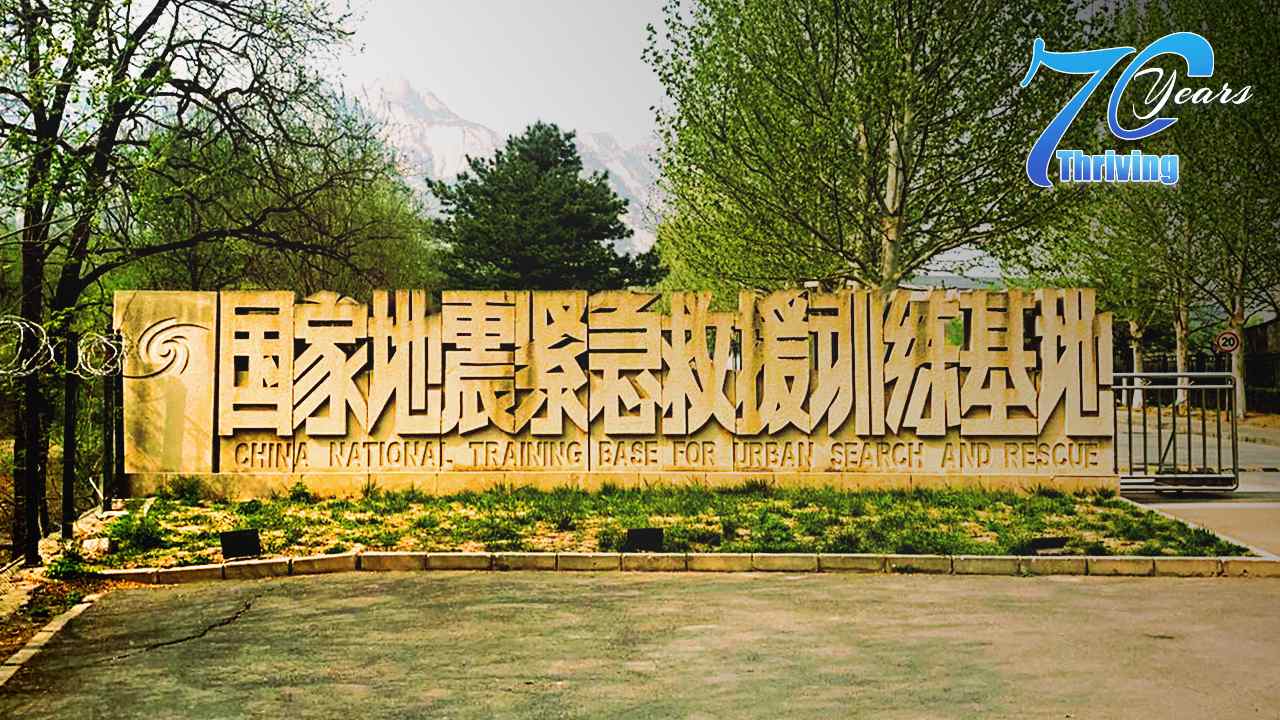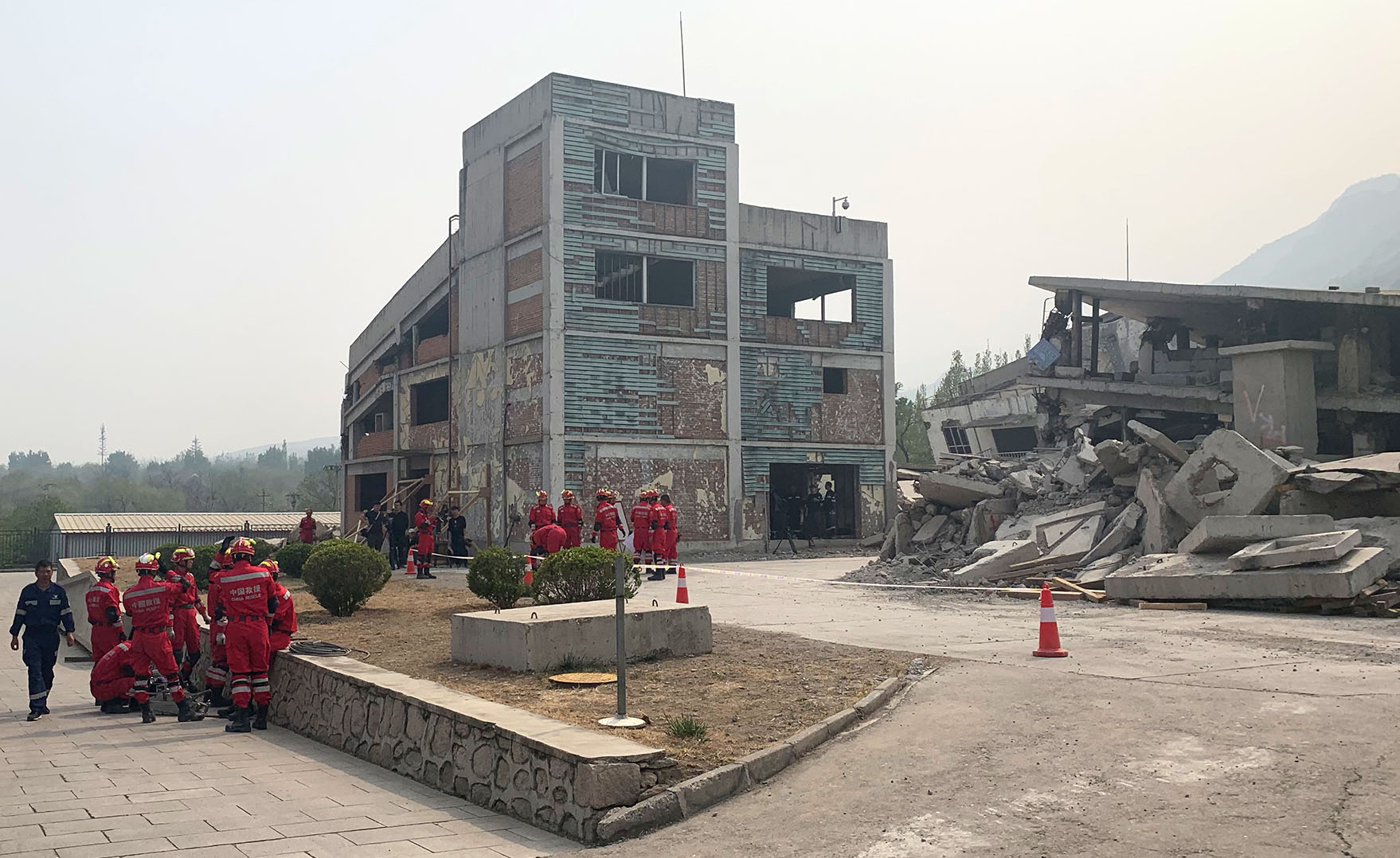
Domestic
22:47, 11-May-2019
A look inside China's National Earthquake Emergency Rescue Training Base
Updated
18:32, 12-May-2019
Shen Anqi
01:04

Sloping buildings, broken concrete slabs, bare steel bars, rubble everywhere. At first glance, it looks like the scene after a great earthquake. Did an earthquake happen here? Of course not. This is artificial construction. A CGTN reporter visited the National Earthquake Emergency Rescue Training Base for an inside look at the training place for earthquake rescuers.
Benchmarking advanced rescue concepts and technologies in earthquake response
At the entrance of the National Earthquake Emergency Rescue Training Base, "post-disaster ruins" covering an area of more than 6,000 square meters catch the eye. They are simulated earthquake-affected training buildings.

Earthquake rescue training ground at the National Earthquake Emergency Rescue Training Base, Beijing, April 17, 2019. /CGTN Photo
Earthquake rescue training ground at the National Earthquake Emergency Rescue Training Base, Beijing, April 17, 2019. /CGTN Photo
The first building is the "inclined tower," which is a simulation of a dilapidated building after an earthquake. This building had a 19-degree incline. While climbing to the top of the building, people might feel dizzy as if it was shaking in the earthquake. According to the training needs, most skewed buildings were designed and built by construction experts. To get the best simulation, some of the infrastructure here was even blasted after being well-built. Next to the dilapidated building, there is an equipment warehouse, where you can see special tools that are used to "rescue" people who are endangered. In addition, there are also smoke and real fire rescue simulation training and an underground pipeline training ground that simulates various narrow spaces. The rescuers could practice pulling victims out from impossible places.

The simulated building "inclined tower" at the National Earthquake Emergency Rescue Training Base, Beijing, China, April 17, 2019. /CGTN Photo
The simulated building "inclined tower" at the National Earthquake Emergency Rescue Training Base, Beijing, China, April 17, 2019. /CGTN Photo
This artificial training ground can create almost all the conditions of burial and can drill almost all search and rescue scenarios. Zhang Tianyu, the instructor of National Earthquake Emergency Rescue Training Base, told CGTN that the training base was designed according to international standards and it's the first professional modern rescue training base in China.
Reinforcing both professional and voluntary rescue team construction
Located at the foot of Fenghuangling Mountain in the northwestern side of Beijing, this 194 mu (12.93 hectares) training base provides training sessions for search and rescue personnel from all over the country, including the National Earthquake Rescue Team and provincial rescue teams, emergency administrative staff at all levels, and social volunteers.

Aerial photo of the National Earthquake Emergency Rescue Training Base, Beijing. /Provided by National Earthquake Emergency Rescue Training Base
Aerial photo of the National Earthquake Emergency Rescue Training Base, Beijing. /Provided by National Earthquake Emergency Rescue Training Base
Since the base was put into use in 2008, tens of thousands of people have received professional earthquake disaster rescue training here, and 86 professional rescue teams from 31 provinces have been set up. In addition, some private rescue organizations have received professional rescue training.
"After the training program, students can master the basic procedures and methods of the earthquake emergency rescue. After returning to their hometowns, their knowledge can be passed like a torch to teach more earthquake rescue personnel," Jia Qunlin, director of the National Earthquake Emergency Rescue Training Base, told CGTN.
Every year, there are more than 3,000 people accepted for training. Since its establishment, the base has organized 322 training programs and nearly 21,000 training sessions. It has enlarged the scale of the rescue team and played an important supporting role for the capacity building of various types of emergency rescue teams in the country.
Actions for enhancing China's disaster-reduction capability
In recent years, destructive earthquakes have happened with more frequency and unexpectedly around the world. They have caused enormous losses of life and property to human society and pose a common challenge to all countries.
China had three of the world's top ten earthquakes in terms of loss of human life. The situation regarding the prevention of and response to natural disasters has become more serious and complicated in China.
May 12 marks China's Disaster Prevention and Reduction Day, which commemorates the 2008 Wenchuan earthquake that left more than 80,000 people dead or missing. Actually, after the earthquake hit, the National Earthquake Rescue Team immediately went into action. They successively implemented rescue work in Dujiangyan, Hanwang town in Mianzhu, Yingxiu town in Wenchuan, and Beichuan – altogether 48 places within 15 days and successfully rescued 49 survivors. Based on the experience learned from the Wenchuan earthquake rescue procedures, this training base took advantage of all the existing resources to ensure a more rapid, more efficient earthquake rescue response.
In addition to the national earthquake rescue, the base also seeks international cooperation in responding to the Belt and Road Initiative. Under the partnership with the United Nations Development Programme (UNDP), the base exchanged knowledge, equipment and skills related to earthquake emergency search and rescue response with organizations from Bangladesh, Nepal, Japan, the UK and other countries.
The base is not only the main organization for China's earthquake emergency rescue training, but also an important platform for the country to cooperate globally in disaster prevention and reduction.

SITEMAP
Copyright © 2018 CGTN. Beijing ICP prepared NO.16065310-3
Copyright © 2018 CGTN. Beijing ICP prepared NO.16065310-3